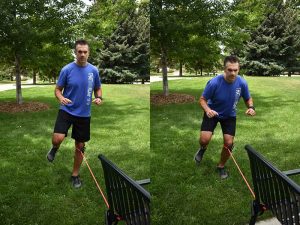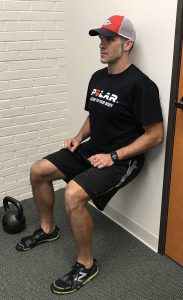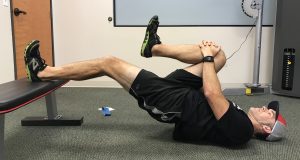Research supports the use of weight and plyometric (jumping) training to aid running performance. Read all about it here, here, here, and here. I lift and jump about twice a week. I expect specific outcomes from the exercises I use. This is a discussion of my strategy.
Plyometrics
In running, the muscles and tendons act as springs. As the foot hits the ground, the muscles and tendons of the feet and legs lengthen and store energy from impact. The stored energy is then released, propelling the runner forward through the gait cycle. (The Achilles tendon is an especially powerful part of the SSC equation.) This process is called the stretch-shortening cycle (SSC.) Plyometric training is a way to build stronger springs. There are many plyometric exercises to choose from. I use two exercises.
- single-leg hurdle hops: This consists of hopping over six low hurdles as quickly as possible. I try to land and balance in control on the very last hurdle. I rest then hop back on the other leg. I accumulate 50-70 contacts on each leg.
- two-leg pogo hops: This is a new drill for me. It’s different from a two-leg jump. I pull the toes up toward the shins when I’m in the air. I slap the ground hard on impact—using only the ankles—while keeping the knees nearly locked. I do 10 reps (20 foot contacts) x 5-7 sets for 100-140 total foot contacts.
You can find a thorough, concise discussion of plyometrics at Sports Fitness Advisor. Their series of articles explains the physiology of plyometrics, exercise selection, rep & set schemes, rest periods, and safety considerations. It’s a good resource.
Key strength exercises
- Calf raises: I worship at the altar of lower leg strength. I’ve been injured there and I want armor the lower legs against injury. A calf raise is a great catchall for not only the calf muscles but the foot muscles and tendons too. Twice a week I do some sort of calf raise or jump rope. I work high weight/low reps and moderate weight/moderate reps.
- Step-up: I’m a trail runner so I step up. A lot. I’ve also had cramping issues in my adductors. My strategy for cramping is to a) go right at the cramp-prone muscles and make them stronger, and b) strengthen the supporting muscles so the cramp-prone muscles will have more help doing their job. This exercise does both. I work 5-10 reps typically for 2-3 sets.
- Various lunges: Running and lunging are biomechanically somewhat similar. They work the hip adductors, abductors, quads, and glutes very well. I lunge forward, sideways, and I rotate left and right to lunge. This is one of many lunges, the offset lunge.
4. Leg curl: Cramps have been a problem in my hamstrings too. This exercise should help strengthen the hamstrings appropriately. It’s also a good glute exercise. I’m able to do almost 20 reps in the single-leg curl. That’s a little high for strength work. I need to find a way to weight this exercise but I’m not sure how…
Other strength exercises
I consider these exercises less vital to running but useful nonetheless. First and foremost, I enjoy lifting. I also like to stay generally strong and resilient and I want to maintain my lifting skills.
- Back squat: I like to squat. Squats build general total-body strength. I work up to three heavy sets of three reps. This keeps me from being very sore and doesn’t overstress my nervous system.
- Incline press, standing press, or dips: I like to maintain some general upper body pushing strength. I work various rep ranges from 3-10.
- Pull-ups: Same as above.
- Ab wheel rollout: It’s one of many good ab exercises. I do two to three sets of 10-15 reps.
- Hitting the heavy punching bag: I’ve done a little boxing training with another trainer and I watch boxing videos. Hitting the heavy bag, throwing combinations, and doing something very different from running is a lot of fun.
- Road cycling and mountain biking: I’m a cyclist! Gotta pedal the machines sometimes. I’m happy if I get two rides per week.
When to lift?
I get the lifting in when I can fit the lifting in. I aim to lift twice a week. I prioritize the calf work and the plyometric work as I believe those are the most important to my running. Running, work, and other responsibilities dictate that some weeks I may only get one day of lifting in.
A common phrase among coaches is, “Make the hard days hard and the easy days easy.” Thus, I try to lift on the hard running days, which are Tuesdays and Thursdays. The problem is I feel better when I have 48-72 hrs between lifting sessions. That means I often lift on easier days. I typically try to do plyometrics on easy days. Plyos should be done in a non-fatigued state. On some lifting days, I feel tired or sore from running, or I may not have time to do everything, so the workout may consist of only one or two exercises for one or two sets. Other days, I feel great and I have plenty of time so I get more work done.
In the grand scheme, I’m more concerned with being consistent, and less concerned about following a precisely perfect schedule. Brad Stulberg has good thoughts on consistency:
CONSISTENCY means showing up, even when you don’t want to. It makes you better at not only your craft—via compounding gains—but also the skill of exerting effort itself. Sustainable peak performance isn’t about being consistently great. It’s about being great at being consistent.
— Brad Stulberg (@BStulberg) April 23, 2018





